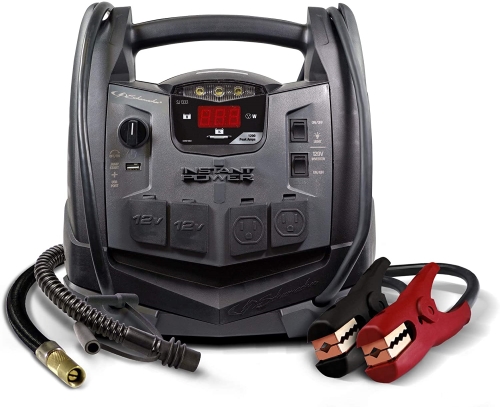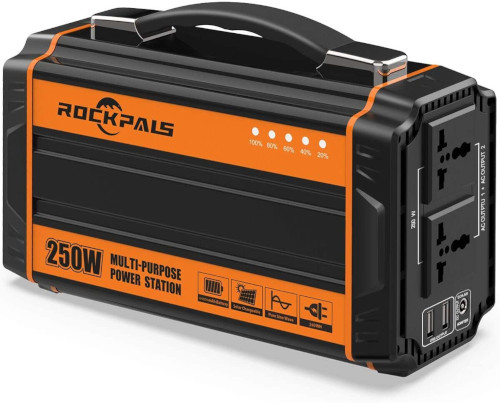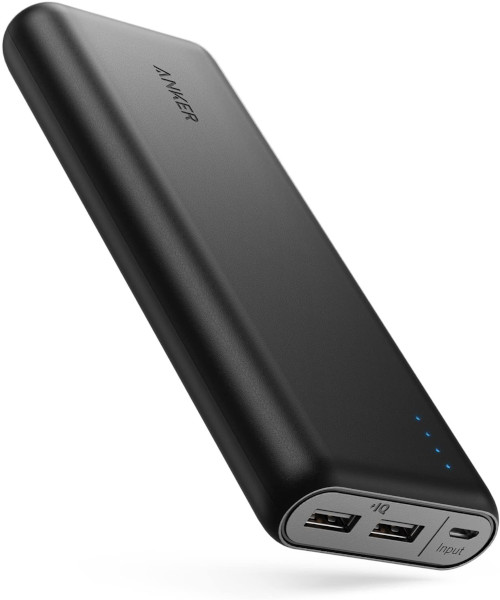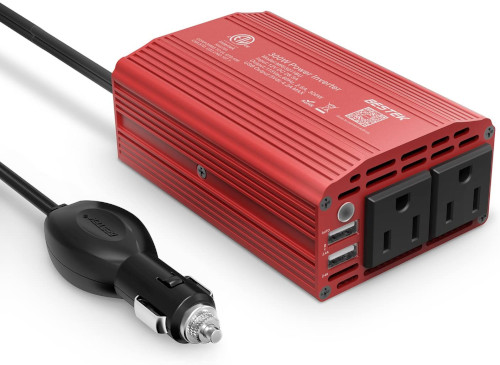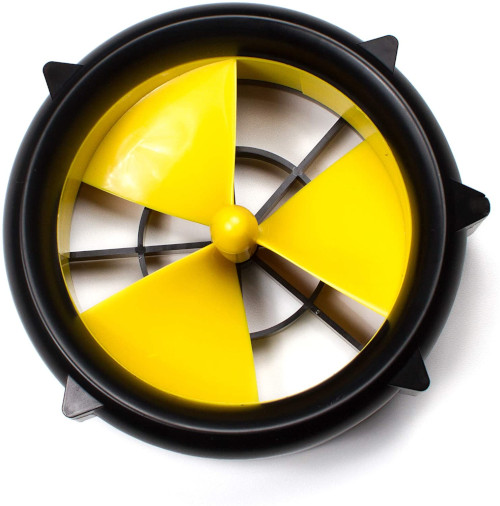One of the things I love most about camping is getting away from my computer for a few days.
It’s nice to have a digital detox and enjoy being outdoors.
Although some campers might want to go completely off-grid for a few days, most still want a few modern-day conveniences.
Having lights, a Kindle or tablet for entertainment, and a charged phone to check the weather forecast (or post your camping pics on Instagram) can make your camping trip feel like a relaxing break rather than a survival experience.
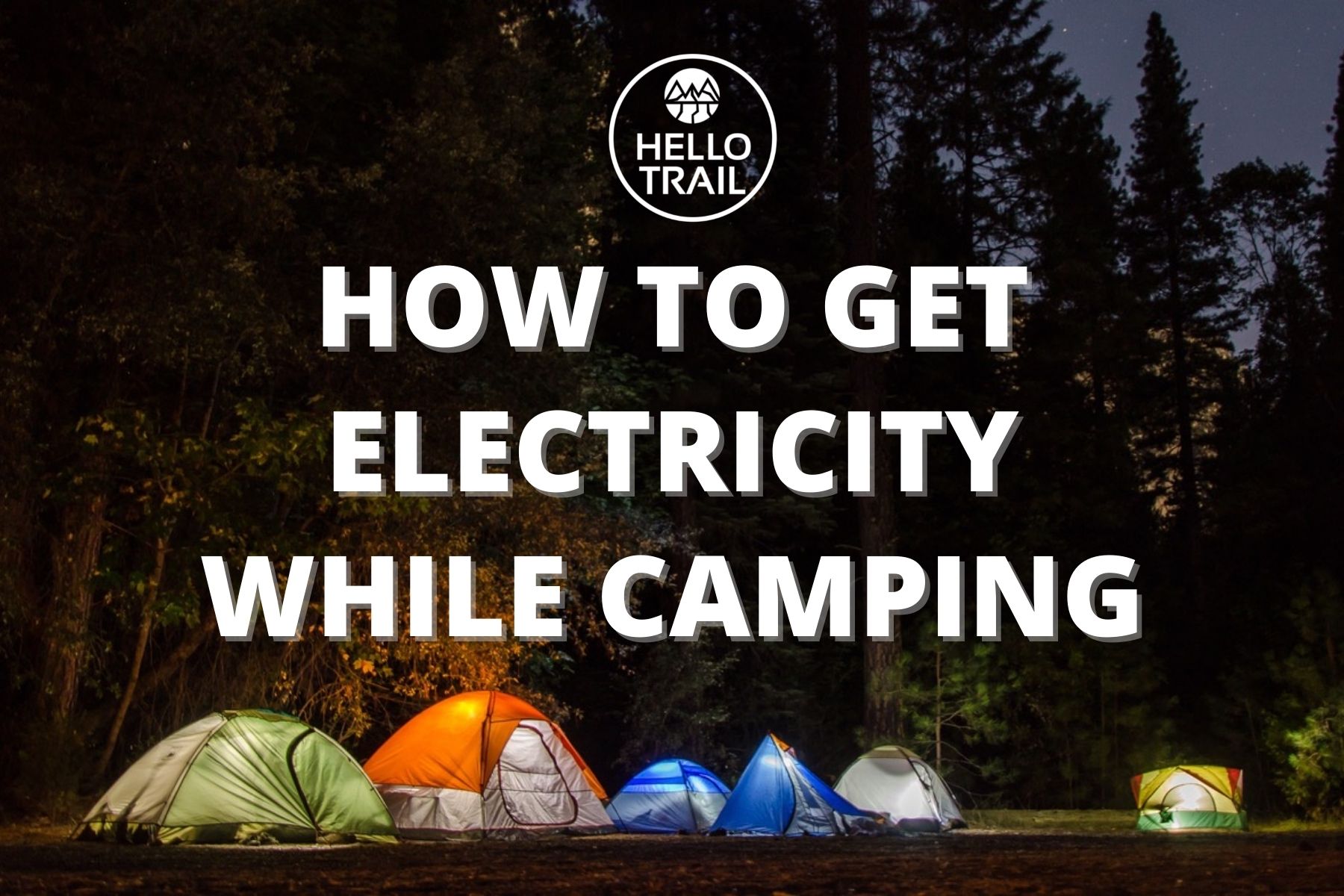
HelloTrail® is reader-supported. We may earn a commission, at no additional cost to you, on purchases made from our expert chosen links.
Love it or hate it, if you’re going away for more than a night, you’re likely going to need some power so let’s take a look at how to get electricity while camping…
- Best Portable Power Station for Camping: Schumacher AGM 1200 Peak Amp
- Best Portable Power Supply for Camping: Rockpals 250W
- Best Camping Power Bank: Anker PowerCore
- Best Power Inverter for Camping: BESTEK 300W
- Best Solar Power Source for Backpacking: Foxelli USB Solar Charger
- Best Wind Power Source: WaterLily Turbine
Camping Power Solutions
1. Generators
A generator may be the first thing that springs to mind when you think about portable power, particularly if you already own one, but there are several downsides to this type of power supply.
First, many campgrounds don’t permit generators on site.
Even if they are allowed, there are usually strict time restrictions on when they can be used.
Plus, it does ruin the peacefulness of the great outdoors.
This brings me to the next problem: generators require fuel. You need to make sure that spare fuel is stored safely away from your tent.
Generators have their uses, but for tent camping purposes, it’s better to leave them at home.
Pros
– Powerful enough to run lights, fridges and anything else that needs power
Cons
– Heavy and Noisy
– Requires Fuel
2. Portable Power Stations
If you want a silent fumeless alternative to a generator, then a portable battery unit is the next best thing.
Typically, these use lead-acid or lithium-ion batteries, which can be recharged at home or using a portable solar panel.
They kick out enough power to charge multiple devices, run lights, and some can even be used to jumpstart your car.
Portable power stations are heavy units – you’re not going to want to carry it any distance – but if you’re going to car camp in style, this is the portable power supply for you.
Pros
– Enough juice to power lights, laptops, and other large items
– Can be charged in the wild if you have a solar panel
Cons
– Heavy and bulky
– Can be expensive
Best Portable Power Station for Camping: Schumacher AGM 1200 Peak Amp
Although the Schumacher SJ1332 is primarily designed to jumpstart your car, this multifunctional portable power station is ideal for heavy power users.
With 400 W of AC power and 12 V DC power, you will be able to keep your tent lit up at night, charge your family’s electronic devices, and if you accidentally leave your car lights on, you’re not going to get stranded.
The air compressor feature is one you don’t typically find on other portable power supplies. The 150 psi unit comes with different nozzles for inflating your car tires, bike tires or sports balls.
You can even use it to blow up your air mattress – how’s that for luxury camping?
Other users have noted the Schumacher portable power supply can provide enough electricity to be used with a CPAP machine for a couple nights of camping without a recharge.
Speaking of recharge…
You will want to make sure to charge the Schumacher power station before heading out on your camping trip as it can take up to 72 hours to fully charge the internal battery.
There are a couple of downsides.
1. It’s heavy (19 pounds) and unlike a generator, isn’t designed to be left out in the rain.
2. It has to be charged from a wall unit via an extension cord (not included).
But if you enjoy camping with your home comforts, the Schumacher Rechargeable 1200 amp portable power station will keep you powered up at a very reasonable price.
3. Rechargeable Power Banks
At the opposite end of the scale, you have portable rechargeable power packs.
You charge them up at home and then use the unit to charge electronic devices when you’re out and about.
Rechargeable power packs vary considerably in size, capacity, and cost, so there’s something for every type of camper and every budget.
The downside of this type of power supply is that once it’s discharged, you’ll need a way to charge it up again whether through an electrical outlet at your campsite, solar charging or plugging into a generator or power inverter.
USB chargers are a great option for weekend camping trips and emergency use, but if you’re going off-grid for a more extended period or you want to charge larger items, a power station may suit you better.
Pros
– Lots of choices at different price points
– Lightweight
– Easy-to-use and good for topping up charge on small electronic devices
Cons
– Not great for longer camping trips
– Limited capacity
Best Portable Power Supply for Camping: Rockpals 250W
The Rockpals 250W portable generator is our personal power source when we go camping.
The ability to charge our laptops at the campsite in a small, lightweight package is ideal. We pair it with Rockpals 100W solar charger and as long as the sun is out, we can stay productive for hours!
There are some power limitations, though.
It takes a while to fully charge one laptop computer, which will drain most of the generator’s power. So you will want to have it connected to the solar charger if possible.
It does come with a car charger and a regular power cord if you happen to be camping near a power source. But really, what fun would that be.
Sure the Rockpals doesn’t have the power of the DieHard, but for most camping power needs, it gets the job done.
Plus, at 5.5 lbs, it’s pretty light for a power station.
You won’t be taking it backpacking with you, but it’s portable enough to carry from your car to your campsite.
Best Camping Power Bank: Anker PowerCore
Not everyone needs a bulky power pack, and if you just want to keep your smartphone, e-reader, and other small devices topped up with power, the Anker PowerCore is an excellent option.
It can charge an iPhone 8 up to seven times and a Samsung Galaxy up to five times – perfect for keeping your cell phone running on camping trips of up to a week.
USB power chargers can often be quite slow when charging your phone, which is a pain if you’re on the go.
You don’t want to charge it at night as you’ll end up draining the device unnecessarily.
Anker’s device will fully charge your phone in just a couple of hours, and if you just need to top it off, this can be done in under an hour.
Some issues have been reported with quality control, but Anker’s customer service team is excellent, and the device comes with an 18-month warranty.
4. Charging From Your Vehicle
A power inverter can be used to charge devices using your car or van battery.
If you’re staying at a campsite and driving every day, this can be a good way to keep your smartphone and laptop charged.
The main issue with charging things off your vehicle is that you could drain the battery and end up on a longer camping trip than you’d anticipated. (Try explaining that one to your boss.)
To avoid this, only use the inverter when the engine is running and ideally while you’re driving rather than just idling the engine.
Pros
– Inexpensive and takes up little space in your car
– Good for charging small devices
Cons
– Risk of draining your car battery, leaving you stranded
– Charging ability is limited by how much you’re driving
Best Power Inverter for Camping: BESTEK 300W
With two 110 V AC outlets and two USB charging points, you can use the BESTEK Power Inverter to charge your laptop, camera battery, smartphone and other devices from your vehicle.
It’s small, lightweight, and most importantly for those on a budget, low-cost.
It plugs into your vehicle via a cigarette lighter plug making it suitable for use in almost any vehicle.
The fan can be pretty noisy, but the inverter copes well with charging multiple devices at once without overheating.
It’s worth noting that although it’s rated as a 300 W device, some users have struggled to charge more power-intensive devices.
Also, when you turn the device off, make sure you unplug USB devices from the inverter, otherwise, they’ll continue to charge and drain your battery.
5. Solar Power Chargers
Solar-powered chargers have increased in popularity over the past decade and have become smaller, lighter and cheaper.
These units are a good option for backpackers and campers who are going to be off the grid for longer than a couple of days as, as long as the sun is out, you can keep things charged.
But what is a blessing can also be a curse…
The effectiveness of solar chargers can be seriously hampered by a couple of cloudy or rainy days.
If you’re camping in a steep-sided valley or forest, then you may get very little direct sunlight which means you can wave goodbye to your GPS unit getting charged.
Solar power supplies can vary considerably in their effectiveness. Generally, the more you pay, the better and more reliable the power charger will be.
Pros
– Can be charged on the move
– Lightweight and packable
Cons
– Only practical in sunny places
– Can be unreliable
– You get what you pay for so reliable units will be pricey
Best Solar Power Source for Backpacking: Foxelli USB Solar Charger
If you’re backpacking for a couple of days and you just need something to charge your phone once or twice, then a small USB power unit such as the Anker Powercore will be your lightest option.
But for longer trips, a solar charger like the Foxelli USB charger gives you more reliability and flexibility.
More importantly, it won’t leave you stranded when you realize your phone battery’s dead and you have no way of calling your ride home.
There are a couple of ways you can use the Foxelli charger.
If you’re staying at your campsite all day, then the quickest way to charge your devices is to place the solar charger in the sun and connect them directly.
If it’s a sunny day, you’ll be able to charge your smartphone in just a few hours.
If you’re hiking, you can also use it on the move by strapping it to the top of your backpack (it comes with a couple of carabiners for this purpose).
Another option is to use the panel to charge portable batteries, which you can then use to charge your phone or camera overnight.
This solar charger isn’t a device for heavy power users.
But if you’re happy leaving your tablet and television at home, this will give you enough power to keep your smartphone running without having to remember to charge a battery up before you leave the house.
Don’t Miss: 18 Great Camping Gifts for Men
6. Water or Wind Turbine
If you’re looking for a niche, environmentally friendly power supply, check out portable devices such as the WaterLily turbine that rely on water or wind to generate power.
Since they don’t need to be recharged using electricity, these are a good option for campers who want to stay off-grid for a while, particularly if you’re camping in a forest or other area where solar power may not be a reliable solution.
Of course, you ideally need some fast-flowing water nearby to power the device.
Either that or a windy camping spot, which comes with its own set of problems.
These aren’t mainstream power units, they tend to be expensive, but they’re worth checking out if the other suggestions don’t adequately meet your needs.
Pros
– Environmentally friendly
– Fills a void that isn’t covered by other types of power supply
Cons
– Expensive
– Requires flowing water or a windy camping spot
– Not very packable
Things to Consider Before Buying Your Portable Power

You wouldn’t use a hammer to crack an egg. Equally, you don’t need a gas-guzzling generator to power a couple of smartphones.
You want to pick the right kind of power supply for the type of camping you do.
Start with…
How Much Power Do You Need?
First and foremost, with any power generating need comes capacity and how long you’ll need that capacity.
Look at your camping gear – what must-have items require charging? There may be more than you think…
If you’re camping for a couple of nights, then you may be able to charge up all your battery-operated devices before you leave home and get away with a small power unit for emergency use.
For longer trips, you’ll want a power pack that can charge your devices more than once and perhaps one that you can recharge in the wild using a solar panel.
Size and Weight
If you’re backpacking or camping any distance from your car, then size and weight will be an issue.
As a general rule, there’s usually a direct relationship between the size and weight of a power source and the amount of power you get from it.
Budget
There are options for portable power at different price points.
If you’re on a tight budget, you may have fewer choices, but you should be able to find something that meets your needs.
Durability
Whereas generators are typically designed for outdoor use, most portable power units don’t like to be left out in the rain.
When it comes to smaller devices, some will survive being tossed around and dropped in the mud, while others require a bit more care.
A rugged power pack designed for the outdoors may be a bigger upfront investment, but it could pay off by lasting much longer than a cheaper, less durable unit.
Wrapping It Up…
As you can see, there is a wide range of different ways to get electricity while camping.
The key to finding the best power supply is to figure out what type of camping you do and what you need to power.
And let’s not forget, if you camp in summer when the evenings are light and you’ve got the beautiful outdoors on your doorstep to explore, it may not be the worst thing in the world if you accidentally leave your power supply at home.
You Might Also Like
Check Out Our Google Web Story – How to Get Electricity Camping

